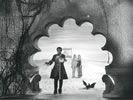Eye For Film >> Movies >> The Saragossa Manuscript (1965) Film Review
"Frasquita told her story to Busqueros, he told it to Lopez Suarez, who in turn told it to Señor Avadoro. It's enough to drive you crazy."
In fact, as Alfonse van Worden (Zbigniew Cybulski) - Captain of the Walloon Guard and hero of The Saragossa Manuscript - tries to get his head round the perplexing chain of nested narratives offered as instructive entertainment by the Gypsy king Avadoro (Leon Niemczyk), he hardly comes close to a full account of what he has just heard or how he himself fits into it. The viewer may not be as foolish as van Worden, but anyone who tries to discern a unifying pattern in the film's dizzying narrative will find themselves, too, courting madness.

No wonder, then, that Wojciech Has' film, adapted from Count Jan Potocki's fabulistic 1813 novel, would become such a cult favourite amongst the drug-addled hipsters of the 1960s. For here was a film so cosmically all-encompassing, so utterly confounding, so mystical and mental, that it could induce a trip-like state in even the most sober-minded of cinemagoers.
Its more outspoken champions have included the surrealist filmmakers Luis Buñuel and David Lynch, as well as rock star Jerry Garcia.
So great was Garcia's love for the film that he began to finance its full restoration in the Nineties, including the reinstatement of an hour of extra material that had been mercilessly cut from the only version of the film previously available to English-language viewers. When Garcia died in 1995, none other than Martin Scorsese and Francis Ford Coppola stepped in to complete the project, and the restored film had its premiere in 1997. It goes without saying that this wonderful new edition, though some 60 minutes longer, is hardly clearer – rather it offers the viewer an even larger and more complex labyrinth of stories in which to become lost.
Indeed, getting lost is what The Saragossa Manuscript is all about. After a brief (and soon forgotten) narrative frame in which a Napoleonic officer and his captor become enthralled by a manuscript they discover in the middle of a Spanish war-zone, we are transported into the middle of a story said to be about the grandfather of one of the two readers.
Bound for Madrid, Alfonse van Worden seeks a route through Sierra Morena, despite warnings that the area is haunted, and stops for a rest at the deserted Venta Quemada inn. There, in the middle of the night, he is seduced by a pair of man-hungry Moorish sisters (Iga Cembrzynska, Joanna Jedryka) who claim he is their cousin through his mother, and who both offer to marry him if he will convert to their Muslim faith. He agrees – and then awakens alongside two corpses on a gallows.
After being warned of the dangers of temptation by a Christian hermit (Kazimierz Opalinski), and being told a cautionary tale not dissimilar to his own by a possessed man with one eye (Franciszek Pieczka), van Worden's every attempt to leave the region is thwarted by bizarre encounters with torturous inquisitors, swashbuckling bandits and the sibling succubi – until, that is, the intrepid fool and his fellow traveller, the logician Don Pedro Velasquez (Gustaw Holoubek), are invited to take refuge at the castle of a cabalist named Uzeda (Adam Palikowski).
There, van Worden finds a manuscript (the very same manuscript that the Napoleonic officer and his captor are now reading), but loses it before he has a chance to read a word for (or, indeed, about) himself. That night Avadoro arrives, and entertains the assembled guests with a diabolically complicated series of erotic tales-within-tales – and then van Worden is summoned back to Venta Quemada, where the secret of the Saragossa manuscript and van Worden's own peculiar role in its construction, is at last revealed – although whether in the end he is sane or mad, enlightened or a dupe, awake or asleep, a reality or a fantasy, living or dead, remains entirely mysterious.
Sierra Morena, the ghostly region through which van Worden is travelling, is said to lie "between Andalusia and La Mancha". This is not, of course, merely a geographical designation but a description of the literary/cinematic terrain that Has' film comes to occupy, falling somewhere between Cervantes' 17th-century comic novel Don Quixote De La Mancha and the landmark surrealist film Un Chien Andalou, concocted by Buñuel and Salvador Dalí in 1929. For The Saragossa Manuscript is a maddening celebration of the power of narrative to amuse, bewilder, disorient and entrap, whose literary lineage can be traced right back to Apuleius' Golden Ass, The Arabian Nights and Boccaccio's Decameron. Its infuriatingly involved structure also has incestuous links to films such as Alain Resnais' Last Year in Marienbad (1961), Federico Fellini's Satyricon (1969), Monty Python And The Holy Grail (1975), Peter Greenaway's The Falls (1980), and almost the entire output of Alejandro Jodorowsky.
Shot in beautiful black-and-white Cinemascope, stridently scored by Krzyszt Penderecki, and featuring performances whose very hamminess, far from grating, only adds to the paranoid sense that you are being taken for a ride, The Saragossa Manuscript is a true masterpiece of modernism. It offers an endless hall of mirrored narratives that in the end reflect no more (and no less) than the viewer's own fears and desires.
Contained within this Chinese box of stories is everything and nothing – all of human life, as well as all its vanity, and one hell of a memento mori. Look hard enough, and you might just catch a glimpse of how the entire universe, and everything in it, fits harmoniously together. Alternatively, you might just get very lost. Either way, you will want to look again... and again... and again...
A lost classic for the lost soul in all of us.
Reviewed on: 09 Apr 2008


















